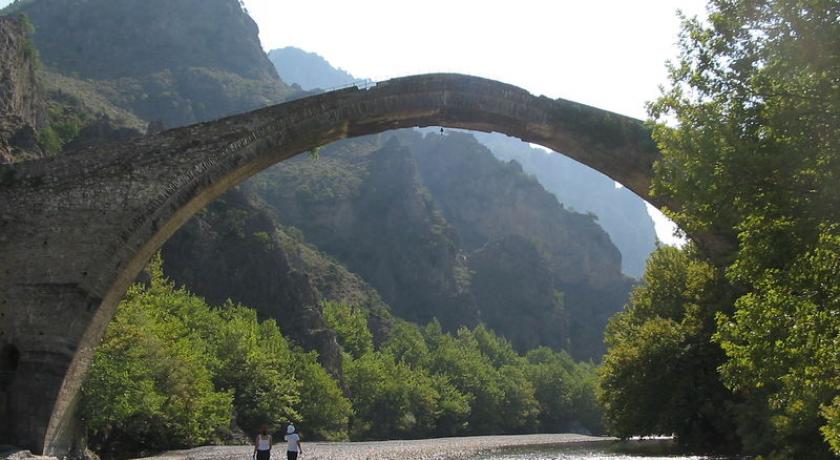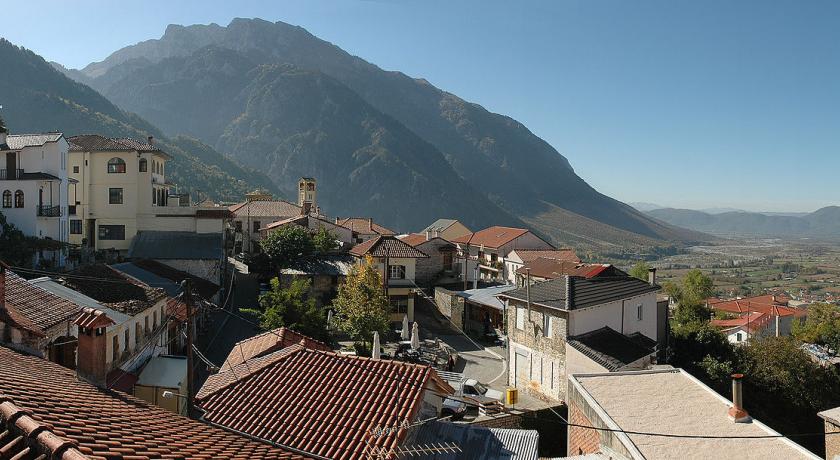Description
Konitsa (Greek: Κόνιτσα) is a town of Ioannina in Epirus, Greece, near the Albanian border. It is located north of the capital Ioannina, and northeast of a group of villages known as the Zagorochoria. The town was built amphitheatrically-shaped on a mountain slope of the Pindos mountain range from where it overlooks the valley where the river Aoos meets the river Voidomatis.
Konitsa acts as a regional hub for several small villages of Pindos, and features many shops, schools and a general hospital. Primary aspects of the economy are agriculture and tourism; it is a popular starting point for tourists and hickers who want to explore the Pindos mountains, or who want to go rafting in the river Aoos or parapenting. Due to Konitsa's closeness to places of particular interest, such as the Vikos–Aoös National Park, which includes the Vikos Gorge, the Aoos Gorge and the Tymfi mountains, where the Vikos spring water brand is collected, the Dragonlakes of Tymfi and Smolikas and the sulfur baths of Kavasila, contributed to the increase of tourism in the region.
Name
The town itself is known in Greek as Kónitsa (Κόνιτσα), the villages surrounding it are often known as the Konitsochoria, meaning "the villages of Konitsa". The town is known in Albanian as Konicë, in Aromanian/Vlach as Conița, and in Turkish as Koniçe.
History
During the Middle Bronze Age (2100-1900 BC) the region of Konitsa was inhabited by Proto-Greek populations. Latter in classical antiquity, the area was part of the territory of the Molossians. At the time of the reign of Pyrrhus of Epirus (297–272 BC) a number of forts existed in strategically important positions.
The town of Konitsa is recorded for the first time under its modern name in the Chronicle of Ioannina of 1380. The chronicle mentioned that the defences of the castle of Konitsa were strengthened by the local Despot of Epirus, due to an imminent attack. In 15th century Konitsa came under Ottoman rule and became part of the Sanjak of Ioannina. The town was the administrative centre of a kaza (Ottoman district).
During the Ottoman period some local Greek landowners converted to Islam to preserve their holdings. These converts formed a powerful and influential group in the area, living in the upper part of Konitsa alongside the Christians. While Christians were a majority in the upper part of Konitsa, the lower part of Konitsa had a Muslim majority, consisting of Muslim Albanian refugees from nearby settlements and regions like Leskovik, Kolonjë and Frashër (today located in Albania) who became agricultural laborers. A Greek school was operating already from the end of the 18th century under Georgios Mostras, student of Balanos Vasilopoulos. Greek education was flourishing and in 1906 the kaza of Konitsa had 31 schools and 1,036 pupils. The functioning of the school was interrupted during the turbulent times of Ali Pasha's rule, however soon after it reopened following the initiative of Kosmas Thesprotos, a student of Athanasios Psalidas. During the 19th century until the early 20th century, the tekke of Konitsa, similarly to other Albanian Bektashi tekkes, was a covert center of culture, learning and tolerance, but also Albanian national activism against the Ottoman Empire. On the other hand, the local Greek population displayed tolerance towards actions by the Albanians that did not reveal chauvinist inclinations. By the late 19th century the town had a Muslim majority population of 62% and was mainly Greek-speaking, while the kaza had a Christian majority. In 1924 Konitsa was a small town that consisted of a total of 800 dwelings, 200 of which were considered Albanian or Turkish. As a result of the population exchange agreement of 1923 between Greece and Turkey, roughly two thirds of Konitsa's Muslims, were considered “Turks by origin” and left for Turkey in 1925. Another part moved to Albania. They were replaced with around 1.000 Greeks from Cappadocia.
During the Greek Civil War (1946–1949) the surrounding region became a major battleground, while in December 1947 communist guerrilla units unsuccessfully tried to capture the town. Almost all buildings inhabited by Muslim Albanians in Konitsa were destroyed during World War II warfare. The communists guerrillas had the opportunity to withdraw and regroup to the People's Republic of Albania and then launch repeated attacks against Konitsa, but were decisively defeated by the Greek army. During the 1950s the Muslim population numbered around 70 families and they further decreased over time to a few families due to conversions to Christianity or migration to their Muslim correligionists in Greek Thrace, in both cases for marriage.
Address
Konitsa
Greece
Lat: 40.115886688 - Lng: 20.855291367





